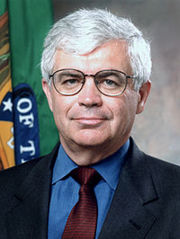約翰·泰勒
出自 MBA智库百科(https://wiki.mbalib.com/)
約翰·泰勒(John Brian Taylor,1946-):當代最知名的經濟學家之一。
目錄 |
約翰·泰勒(John Brian Taylor)出生於1946年12月8日,是美國斯坦福大學教授,胡佛研究所高級研究員[1];當代最知名的經濟學家之一,《巨集觀經濟手冊》的主編。同時,泰勒教授也是最重視經濟學原理教學的學者之一,他多年來堅持在斯坦福大學為本科生開設的經濟學原理課程在全美享有盛譽。
約翰·泰勒曾擔任過斯坦福大學的經濟政策研究組成員,現已成為高級導師,他是斯坦福大學的介紹性經濟學中心的主要創辦人,泰勒目前是加利福尼亞州經濟顧問委員會成員, 1996年至1998年他也在那裡任職。1976年至1977年,他曾擔任總統經濟顧問委員會高級經濟師,並從1989年至1991年成為總統經濟顧問委員會成員。1995年至2001年,他也是美國國會預算辦公室的經濟顧問小組成員。
約翰·泰勒曾於2005年獲得美國財政部亞歷山大·漢密爾頓獎和2005年斯坦福大學喬治·舒爾茨公共服務獎。
泰勒的專業知識和學術領域主要為巨集觀經濟、貨幣經濟學和國際經濟學。他對現代貨幣理論和政策的研究為中央銀行和世界各地的金融市場分析奠定了基礎。他在1993年所提出的貨幣政策規則“泰勒規則”,已為包括美聯儲在內的各國中央銀行所奉行,其後的貨幣政策規則研究也主要是對其理論的發展,或是致力於參數的選取方面。該規則的核心是通過國內生產總值(GDP)、消費者物價指數(CPI)等巨集觀經濟的當期數據,來定量地預期該國央行未來的貨幣政策行動的模型。從投資實務的角度而言,泰勒規則被廣泛用於利率期貨等投資的分析中。[1]
John Brian Taylor (born December 8, 1946) is an economics professor at Stanford University.
Born in Yonkers, New York, he earned his A.B. from Princeton University in 1968 (obtained an education deferment) and Ph.D. from Stanford in 1973, both in economics. He taught at Columbia University from 1973–1980 and the Woodrow Wilson School of Princeton from 1980–1984 before returning to Stanford. He has received several teaching prizes and currently teaches Stanford's introductory economics course. Taylor is mentioned as a potential recipient of the 2009 Nobel Memorial Prize in Economic Sciences.[2]
An expert on monetary policy, in a 1993 paper he proposed the Taylor rule, which provides a guide to central banks on how to determine interest rates. He has also been active in politics, serving as the Under Secretary of the Treasury for International Affairs during the first term of the Bush Administration. He was also a member of the President's Council of Economic Advisers during the Ford and George H. W. Bush administrations.
Taylor contributed to the development of mathematical methods for solving macroeconomic models under the assumption of rational expectations. In 1977, Taylor and Edmund Phelps, simultaneously with Stanley Fischer, showed that monetary policy is useful for stabilizing the economy if wages are sticky, even when all workers and firms have rational expectations. This demonstrated that some of the earlier insights of Keynesian economics remained true under rational expectations. This was important because Thomas Sargent and Neil Wallace had argued that rational expectations would make macroeconomic policy useless for stabilization; the results of Taylor, Phelps, and Fischer showed that Sargent and Wallace's crucial assumption was not rational expectations, but perfectly flexible prices.[3]
Taylor's model of overlapping wage contracts became one of the building blocks of the New Keynesian macroeconomics that rebuilt much of the traditional IS-LM model on rational expectations microfoundations. The New Keynesian economists went on to explore what types of monetary policy rules would most effectively reduce the societal costs of business cycle fluctuations: should central banks try to control the money supply, the price level, or the interest rate; and should these instruments react to changes in output, unemployment, asset prices, or inflation rates? Taylor's 1993 paper in the Carnegie-Rochester Conference Series proposed that a simple and effective central bank policy would manipulate short-term interest rates, raising rates to cool the economy whenever inflation or output growth becomes excessive, and lowering rates when either one falls too low. Taylor's interest rate equation has come to be known as the Taylor rule, and it is now widely accepted as an effective formula for monetary decision making. Some empirical estimates indicate that many central banks today act approximately as the Taylor rule prescribes, but had failed to act according to the Taylor rule during the inflationary spiral of the 1970s.[4]
- ↑ 1.0 1.1 危機“良醫”最有望奪魁
- ↑ "Thomson Reuters predicts the Nobel Prize in Economic Sciences", Thomson Reuters, September 25, 2009
- ↑ Blanchard, Olivier (2000), Macroeconomics, 2nd ed., Ch. 28, p. 543. Prentice Hall, ISBN 013013306X.
- ↑ Clarida, Richard; Mark Gertler; and Jordi Galí (2000), 'Monetary policy rules and macroeconomic stability: theory and some evidence.' Quarterly Journal of Economics 115. pp. 147-180.








